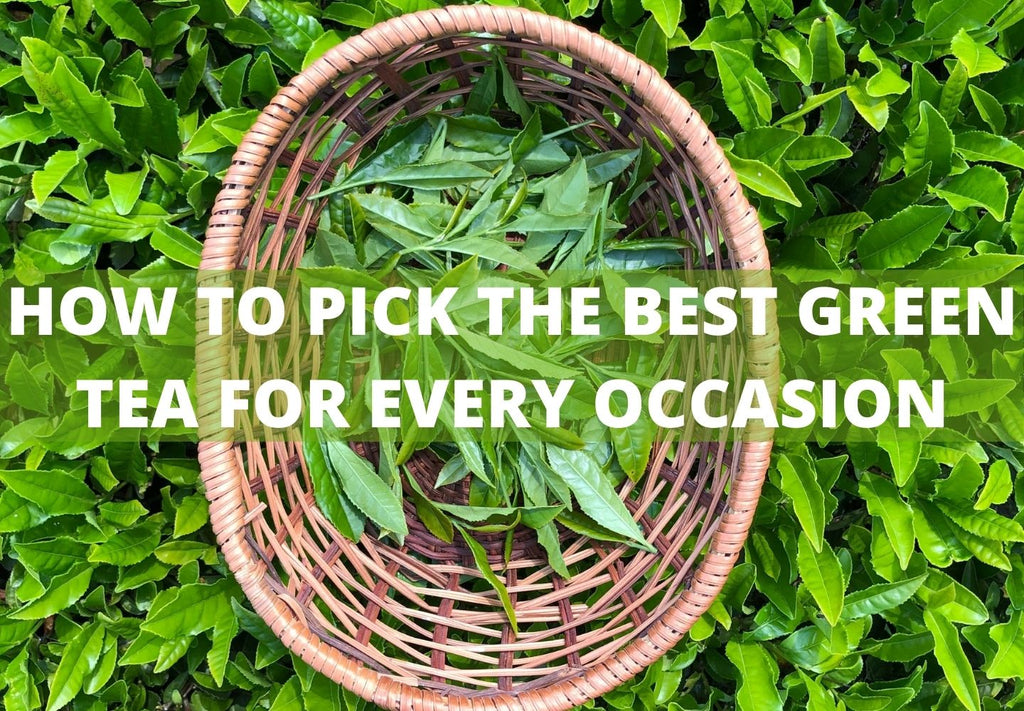
If you’re looking for the best green tea for any occasion, you’re in luck! Our founder and certified tea sommelier, Valerie, has created this green tea rundown. Whether you’re looking for the perfect cuppa to relax with at the end of a long day, or just a great everyday drinker – this article has you covered.
A brief history of green tea
All teas originate from the same plant, Camellia Sinensis. The difference comes in the processing of the leaf!
The key with green tea is in the oxidation (or lack of!). While black teas are heavily oxidised, green teas are not at all. Quickly after the leaves are picked they are put through a heating process to kill the enzymes that would react with oxygen.
The big division that people often talk about when comparing green teas is panning versus steaming. The leaves are either exposed to a dry heat (panning), or a wet heat (steaming). The common misconception is that steamed green tea is Japanese, whereas panned is Chinese. It’s far more nuanced than that though.
Both techniques originate in China. When early Japanese Buddhist monks first travelled to China, the common method of heating was steaming. They learned this technique and took it back to Japan with them. This technique largely stuck around in Japan, with the most famous Japanese green teas being steamed.
Conversely, in China tea production techniques evolved and moved towards panning. Today, the majority of Chinese green tea is panned.
We like to think of the difference as like cooking vegetables. You can roast, boil or steam a carrot and get different flavours – it’s all the same vegetable though!
If you really want to delve into the production of tea, including green teas, check out our guides to loose leaf tea and the different types of tea. We go into a lot more detail around origins, production methods and flavours there.

Which is the best green tea for me?
Best everyday drinking tea – En Shi Yu Lu
One of China’s most famous teas. En Shi Yu Lu a.k.a. Jade Dew is a unique steamed tea from En Shi City in the Hubei Province. As we mentioned earlier, Chinese green tea is mostly panned – this was also the case for En Shi Yu Lu. But in the early 20th century the ancient method of steaming was revived.
If you’re looking for the best green tea for everyday drinking, this could be the one for you. Winning a star at the 2019 Great Taste Awards, it’s easy on the palate and easy to drink!
Go check out our En Shi Yu Lu (Jade Dew) Organic.
Best relaxing tea – GABA Sencha
Looking for the best green tea for relaxing? Look no further than GABA Sencha.
GABA (Gamma-Aminobutyric Acid) is a chemical messenger that lowers stress, improves sleep and reduces anxiety. In the 1980s Dr. Tsushida discovered that processing tea leaves in a nitrogen-rich environment increases the GABA levels. A standard cup of tea has arounds 6mg of GABA per 100g tea, GABA teas have at least 150mg per 100g – at least 25 times more than the average cuppa!
GABA Sencha is more buttery than a regular Sencha, but still has the unmistakable notes of spinach, seaweed and umami.
Go check out our GABA Sencha Green.

Best with a savoury meal – Genmaicha
Popcorn is actually a misleading name, because Genmaicha ‘Popcorn’ tea doesn’t contain any corn! It’s actually a blend of roasted brown rice and Japanese sencha tea.
It’s a really popular everyday drinking tea in Japan. It’s often served in large bowls and the roasted rice is spooned out to be eaten as a snack. We think Genmaicha makes a great accompaniment to a meal though!
Distinctive toasted notes of rice and nuts come through, accompanied by sweet grassy green tea notes.
Go check out our Genmaicha 'Popcorn' Organic Green
Best breakfast tea – Gunpowder Green Tea
A hugely popular Chinese green tea. The leaves are rolled into tight balls, said to resemble pellets of gunpowder, hence the name! The pellets vary in size with the leaf grade – the smaller the pellets, the higher the quality.
As the tea brews the pellets unfurl, producing a strong tea with smoky undertones. The strength comes from the method of processing that the leaves undergo. They are pan-fried like most Chinese green teas. However, Gunpowder teas have the lid left on, trapping moisture and intensifying the flavour.
The result is a more nutty and marine flavour, with a darker brew than most green teas. If you like a strong cup of tea in the morning, the best green tea for you could well be Gunpowder!
Go check out our Gunpowder Green.

Best cold brew – Jasmine Tea
Our Jasmine Dragon Pearls is an exquisite scented green tea from Fujian, China.
After picking, the leaves are rolled into small pearls with the silver bud still visible. These pearls are then layered with fresh jasmine flowers overnight, scenting the tea with their distinctive aroma. This process is repeated each day, up to 10 times, with fresh flowers being used each time.
It’s a really well balanced tea – both refreshing and sweet. We love it as a cold brew tea, though it of course works really well for a hot one too. You’ll possibly be familiar with it and the way that the pearls unfurl as the tea brews.
Go check out our Jasmine Dragon Pearls.
Best adventurous tea – Kukicha
If you’re feeling adventurous, we think the best green tea for you could be our Kukicha.
It’s an unusual organic green tea from Japan, made from the stalks and stems removed during Sencha production. During the production of most teas, the final stage involves removing fibrous content and dust. Sencha is different in that the stems and stalks are also removed.
They’re then used to make Kukicha – Kuki translates to stalk, and Cha is tea. Because there’s no tea leaf involved, the caffeine content is lower than most teas.
You can expect a similar flavour to Sencha – buttery, spinach and umami notes. But it’s more delicate, sweet and has nutty undertones.
Go check out our Kukicha Organic Green.

Best delicate drink – Longjing Tea
Longjing (or Long Jing) Dragon Well is a world-renowned tea from the Zhejiang province of China. The environment is very humid which is key to developing the unique flavour of this particular tea.
Longjing is named after an old well in the hills near the lake. There’s a local legend that says stirring the surface causes water to rise from the depths of the well, swirling in dragon-like curves on the surface!
It’s a very delicate drink, so if that sounds like your cup of tea, we’d recommend giving it a try. It has flavours of young spring vegetables, along with umami and nutty notes. It was even awarded 2 stars at the 2020 Great Taste Awards!
Go check out our Long Jing Dragon Well Green
Best after meal tea – Moroccan Mint Tea
If you’ve ever been to Morocco, we’ve no doubt you’ve had at least one cup (probably many) of sweet mint tea. It’s been part of their life for centuries – business or social occasions always start with a pot of mint tea.
Traditionally a Chinese gunpowder tea is brewed along with fresh mint leaves, in a highly decorated metal tea pot. The tea is drunk hot and sweet. It’s usually poured from a great height into small glass tea cups, which causes tiny bubbles to form on the surface – it’s quite a spectacle!
Peppermint is a great digestive aid, so this is the best green tea for an after meal brew. For an authentic taste, try adding a bit of sugar!
Go check out our Moroccan Mint Organic.

Best strong cuppa – Sencha Tea
Sencha tea is the most popular tea in Japan. As you might expect, it’s steamed! The first flush is picked in early spring while the leaves are young. This results in a tea that is full of layered of buttered spinach, umami and subtle marine notes.
The needle-shaped leaves are quite distinctive, dark green and glossy. The resulting brew is a bit cloudy, but this is quite normal for steamed green teas.
Our organic Sencha is another one of our Great Taste Awards winner, earning 1 star in the 2020 awards. We think that it’s the perfect strong green tea and it’s very popular amongst our customers.
Go check out our Sencha Organic Green.
So, what’s it to be? We hope that we help you to find the best green tea for you!
Why not sign up to our Tea Club subscription to get a variety of teas through your letterbox each month?